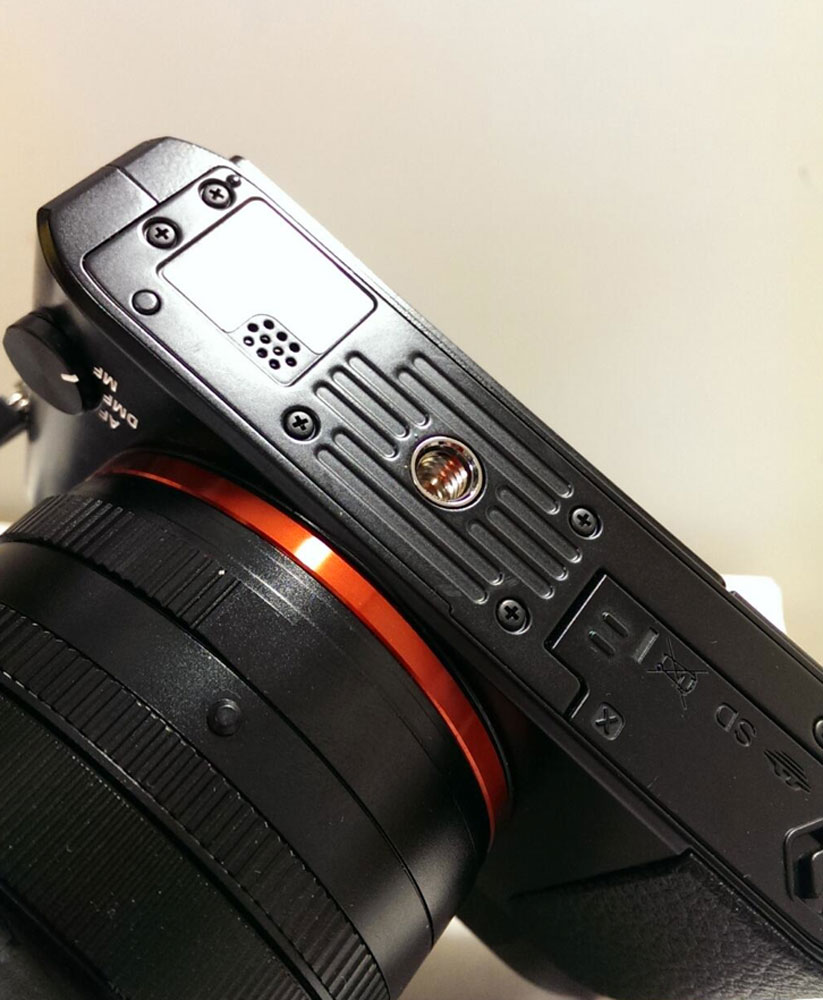The hard-working Fujirumors is keeping Fujifilm's fan base up to date with X-T1 images, leaks, and specs. A recent glut of leaked images shows a generally well-designed camera. But with ownership of the Sony a7r in my sails, the X-T1's release horizon fills me with as much trepidation as it does excitement.
EVF
I purchased the Sony A7r in order to replace my D800 when on location product shoots. As I outlined earlier, the Sony A7r's live view is far better than the D800's is. Currently, I am shooting 200 images for the 2014 edition of Headphone Book, the Japanese Bible of Headphones. (If you're a geek, you'll probably enjoy the English version.) In shooting audio products, I use the Nikkor PC Micro 85mm 2,8 ED (first version) as well as the insanely sharp Nikkor 50/2 Ai.
The latter lens pops into focus on a Nikon SLR. When attached to a Sony a7r, it does not. Why? The simple reason is that a resolution of 1024*768 lines, or 2,36 million dots, is still too low to resolve fine details sans magnification. It is my biggest of many concerns regarding the A7r. Even with highlight peaking engaged, it is faster and more accurate to use a large, bright OVF. In fact, even the Nikon D200's small, cropped OVF focuses the same lenses faster and with more accuracy than does the Sony A7r's focus peaking system.
Of course OVFs can't magnify the image. But when shooting sports or events I don't need them to. I need only to clearly see the image in as much detail as possible. And currently that is possible through bright OVFs.
Fujirumors quote the yet unverified spec of 2.36 million OLED, 0.005s lag. The former spec matches the Sony a7/r. Faster refresh rate is important. But increasing the magnification of a low-resolution screen to 0,77x will exacerbate resolution issues even further. At this point, I would prefer an X-Pro 1-sized EVF with 2,36 million dots to an SLR-sized EVF of the same resolution. Perhaps someday the EVF's apparent resolution will catch up to the OVF. Today is not that day and no matter how good the X-T1 may be, it will not be the mirrorless camera to replace the DSLR for fast focusing of manual lenses.
base plate
The current X-Pro 1 joins the magnesium front plate and plastic rear control plate in a single bottom seam. This base plate is marginally sturdier and thicker than is the the Sony a7r base plate. Both are too slippery and neither is perfectly stable. As indicated in my recent (and rancorous) Benro blast, like the Sony A7r, when attached to typical tripod quick releases, the X-Pro 1 is subject to incredibly fast base plate wear and potential breakage. Even the thickness of the threaded filter grommet is thinner than that of the Olympus' OM-D EM-1.
The X-Pro 1 wooed me with wonderful output colours, simple haptics, and classic ergonomics. By and large, it is easier to shoot with than any DSLR. But in certain key areas, it is less sturdy.
And the X-T1 appears to utilise a very similar base plate to the X-Pro 1. Here it is magnified with mid tones raised to reveal the details of the tripod thread portion of the base plate. Even if both halves of the camera were magnesium, my concerns would stand. Mostly likely they are not. The metal utilised in the filter grommet is thin and the base is split in half around the tripod socket, weakening the entire camera.
Fuijfilm X-T1 tripod socket enlarged
For comparison, this is the far sturdier base plate of the Sony RX1. It was taken by fellow drinker, Martin Irwin. Thank you.
NOTE: RX1 utilises less metal around the tripod filter grommet than does The OMD-EM1 but its bottom plate is a sturdier single element design.
Finally, the Sony A7r is squared off against the Olympus OMD-EM1.
Left: Olympus OMD-EM1; Right: Sony A7r.
The Olympus baseplate runs the length of the camera and is made from a single reinforced element. Its metal grommet is better reinforced than the A7r's is. It is the sturdiest of the bunch.
If the mirrorless camera is destined to replace the DSLR, it first must sport an EVF that is as capable as a good OVF to resolve the smallest details without resorting to peaking or magnification. Current technology isn't up to the task. Where current camera manufacturers, apart from Olympus, have failed is in creating an expensive mirrorless camera that can stand toe to toe with even meagrely priced DSLRs. Finish quality be damned, in the long run, build quality is what matters.
Merely adding magnesium to a front plate and advertising metal! isn't enough to make a sturdy camera. It works wonders for marketing and may woo the masses. But many serious photography enthusiasts are waiting for a mirrorless that competes on more than just size and image quality. It seems that like a boat adrift, that wait could be a long salty tour to a neoplastic heaven.




